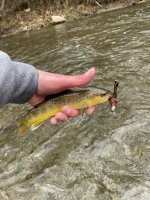5
5wtGuy
New member
I have a question for everybody and I want to preface it by saying I am not asking for spots but rather advice on streams. I have been fly fishing since I was 12 but have always fished very small flies. 16-24 on average and don't keep anything bigger than 12 on me. However this upcoming year I have decided I want to dedicate as much of the year as possible to throwing big streamers for big trout. I have been tying a bunch of Kelly galloups flies and similar in preparation. My question is my main creek is Yellow Breeches. Is it worth it to spend days throwing articulated streamers there? Does anyone here do it with any success? Or am I better off focusing on Little Juniata or Penns which are both 2 and a half hour drives for me. I guess what I am getting at is does Yellow Breeches have enough big browns (18+ inches) to justify targeting them?






